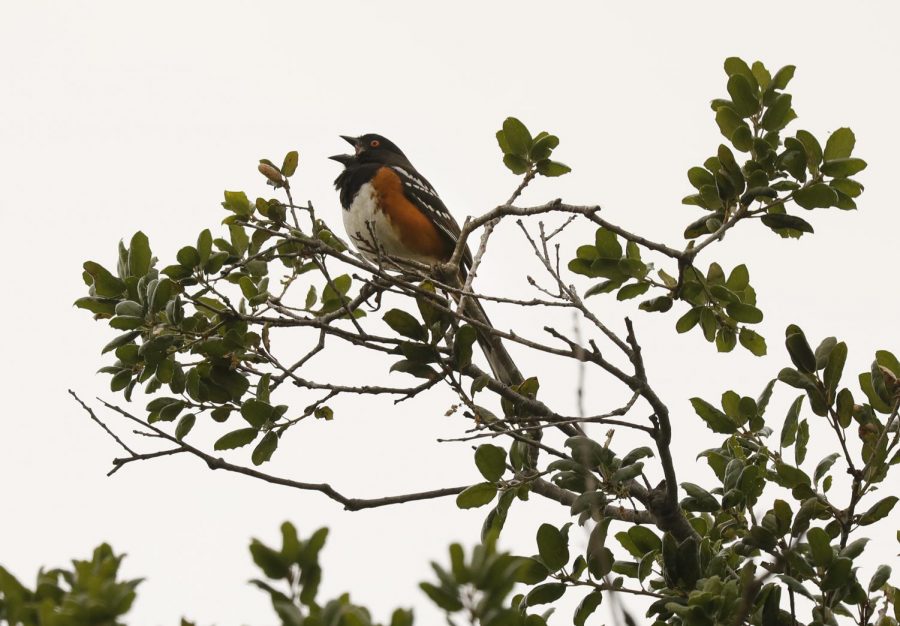As humanity hides from coronavirus, wildlife reclaims lost territory
April 28, 2020
LOS ANGELES — Naturalist Gerry Hans stood in the middle of a lonely road in Griffith Park on Saturday, inhaled deeply though his face mask and admired the natural sights and sounds of an oddly serene landscape that typically draws thousands of visitors each weekend.
“It’s sheer heaven not hearing the deafening clatter of tourist helicopters hovering over the Hollywood sign,” he said, with an appreciative sweep of his eyes.
As California’s coronavirus lockdown enters its second month, some residents on the edges of Griffith Park and other urban ecosystems swear that Mother Nature is reclaiming territories that once echoed with humanity’s tumult.
On message boards, shut-ins trade emotional “coyote talk,” recounting the movements of stealthy canids as they search for prey along quiet streets. Others share snapshots of hawks and owls nesting in the trees of city parks and center dividers, and of raccoons and rats raiding trash cans, suggesting that — by bits and pieces — wildlife is restaking old claims.
Although local experts insist these creatures were always there, and were just ignored in more industrious times, shelter-at-homers are enjoying a rare glimpse into Southern California’s natural heritage.
On Hans’ expedition Saturday, the loudest sounds were the trills and chatter of resident woodpeckers and migrating birds — western tanagers, black-headed grosbeaks, hooded orioles and warblers — moving through the boughs of sycamores, pine trees and gnarled oaks.
Just out of view, in the park’s canyons and slopes, lurked opossums, skunks, coyotes, deer, bobcats and a lone mountain lion known as P-22. An eerily quiet parade of visitors clad in ball caps, running shoes and face masks ambled along a stretch of Western Canyon Road that is usually choked with cars and tour buses.
Roadkill of western gray squirrels, brush rabbits, ring-necked snakes and western toads has plummeted to zero, according to Hans, a wildlife expert with the nonprofit Friends of Griffith Park. And for the first time in memory, rare peregrine falcons have been seen swooping over the Hollywood sign, instead of in the vicinity of downtown skyscrapers, where they nest and dine on pigeons.
While naturalists like Hans have thrilled to the prospect of new wildlife sightings, some Southern California residents have been rattled by their brushes with the great outdoors.
On March 18, a resident of the Villeurbanne townhomes in Orange posted this warning on Nextdoor: “This evening while walking my dogs, a pack of six coyotes saw us, stopped running and two started heading my way. I held the dogs close and started yelling at the coyotes, then they stopped long enough for me to duck behind the houses getting in the back gate. So scary!”
Responses the next day included this one: “The coyotes think we all moved away with no cars driving around.”
Wildlife biologists, however, say this rich urban ecosystem was always there, and it is too early to know how the wild side of Los Angeles and Southern California is responding to the month-old lockdown.
For example, research biologists have seen no evidence that Southern California’s increasingly isolated and inbred populations of mountain lions are benefiting from far fewer vehicles on freeways cutting across their ever-shrinking islands of habitat.
“There is no evidence that the animals that we’re tracking are crossing freeways any more in the last couple of weeks,” said Seth P.D. Riley, wildlife ecologist and branch chief for the National Park Service’s Santa Monica Mountains National Recreation Area. “But that is not too surprising — it is a very short time frame.”
While there are fewer vehicles on roads and freeways these days, there are “still quite a few, from a wildlife perspective, especially during midday, early a.m., and evening hours,” he added. “The couple of animals that have happened to have been near freeways recently have not crossed. Of course, we cannot interview them, sadly, to find out what they are thinking.”
Similarly, research scientist Niamh Quinn, who serves as human-wildlife interactions advisor for UC Cooperative Extension, said none of the five collared coyotes she is studying in the cities of Hacienda Heights, Roland Heights, La Verne and Chino Hills “have changed their behavior yet.”
“I do believe, however, that human behavior has been altered significantly by the lockdown in ways that are closing the gap between us and what’s wild around our own homes — and that’s great, up to a point,” she said.
She worries that animals may be pushed into closer conflicts with humans. “We have to interact with wildlife from a distance. That is because we still do not know all the diseases that, say, coyotes and rats carry with them.”
Despite reports of emboldened coyotes in urban settings, there is no evidence of an increase in the rate of coyote attacks since the lockdown went into effect, according to the Los Angeles County Department of Public Health.
In any case, conservationists are rejoicing in the scene at Griffith Park a month after its roads were closed to traffic and its trailheads were blocked to keep out hordes of daytripping parents and children mingling with tourists for a hike up scrubby slopes and canyons.
Directly in front of Hans on Saturday, western gray squirrels casually crossed Fern Dell Drive at Griffith Park’s southwestern edge, near where it had been cordoned off with yellow tape. To the left, woodpeckers hunted for insects in sycamores shading an empty parking lot.
“Follow me. I want to introduce you to some new arrivals,” said Hans, leading up a gentle slope to a flat spot in a grove of oaks. “Hear that chattering up high in the trees?” he whispered with a smile. “That is the call of Cooper’s hawks fortifying a nest.”
That nest was not the only reason conservationists have plenty to crow about this year. The 2020 Griffith Park raptor survey tallied 122 active hawk, falcon and owl nests — a record jump from 60 nests counted a year ago.
But raptors are sensitive to human disturbance — so sensitive that human activity can cause them to abandon their nests.
“Noisy crowds are a big issue for Griffith Park’s raptors during their breeding season,” Hans said. “Perhaps not quite so much this year. We’ll see.”








